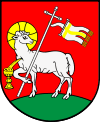Wieluń
Wieluń [ˈvjɛluɲ] (German: Welun, Latin: Velun) is a city in central Poland with 22,973 inhabitants (2016).[1] Situated in the Łódź Voivodeship (since 1999), it was previously in Sieradz Voivodeship (1975–1998).
Wieluń | |
|---|---|
 Old town in Wieluń | |
 Flag  Coat of arms | |
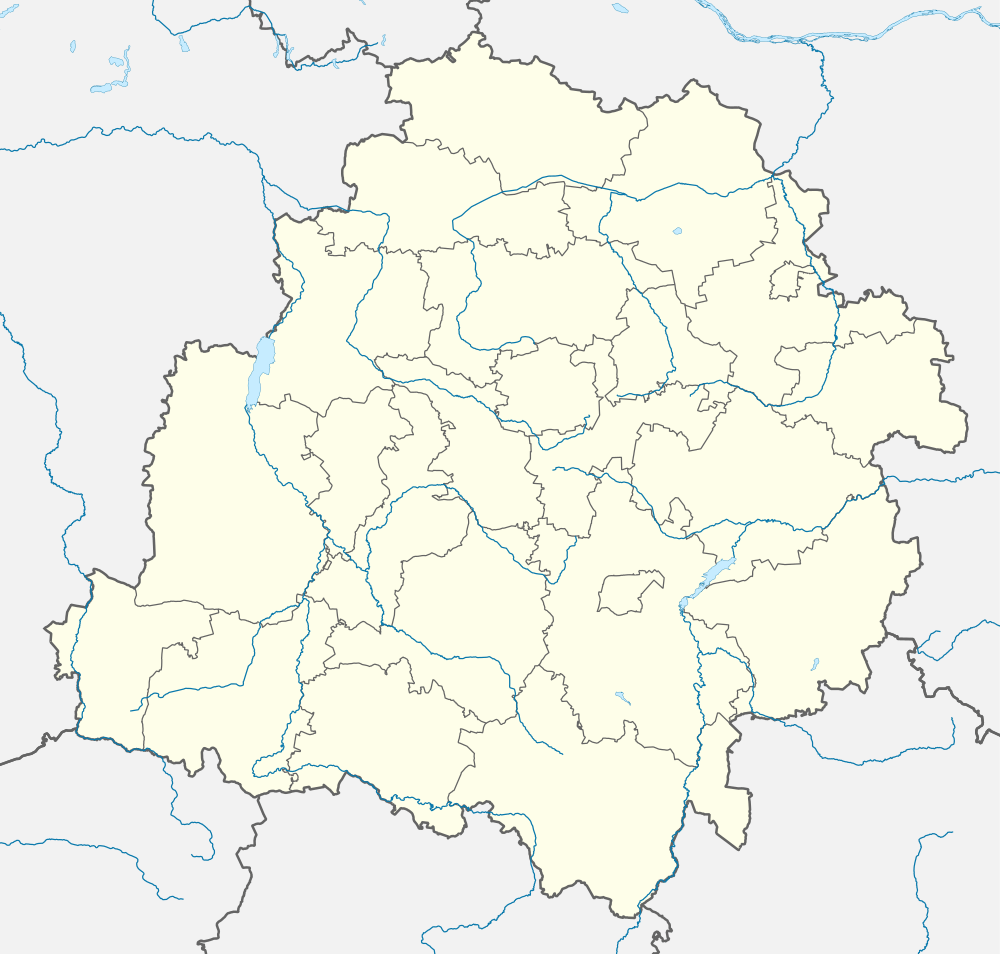 Wieluń  Wieluń | |
| Coordinates: 51°13′14″N 18°34′12″E | |
| Country | |
| Voivodeship | |
| County | Wieluń County |
| Gmina | Gmina Wieluń |
| City rights | 1283 |
| Government | |
| • Mayor | Paweł Okrasa |
| Area | |
| • Total | 16.9 km2 (6.5 sq mi) |
| Population (31.12.2016) | |
| • Total | 22,973 |
| • Density | 1,400/km2 (3,500/sq mi) |
| Time zone | UTC+1 (CET) |
| • Summer (DST) | UTC+2 (CEST) |
| Postal code | 98–300 |
| Area code(s) | +48 43 |
| Car plates | EWI |
| Website | http://www.wielun.eu/ |
Wieluń has a long and rich history. In the past, it used to be an important urban trade centre of the Polish Kingdom because of its proximity to the old German border. Several Polish kings and notables visited the town, but following the catastrophic Swedish invasion (1655–1660), Wieluń declined and never regained its status. In September 1939, during the Invasion of Poland, it was heavily bombed by the Luftwaffe. The Bombing of Wieluń is considered to be the first World War II bombing in Europe. It killed at least 127 civilians, injured hundreds more and destroyed the majority of the town.
Wieluń is an important road junction, the town also has a sports club WKS Wieluń, established in 1957 after a merger of two earlier clubs. In the past, WKS Wieluń had several departments, such as track and field, basketball, table tennis, handball and association football. Currently, the only remaining department is football.
Origin of the name
Wieluń was first mentioned in a 1282 document as Velun (in 1283: Vilin). The exact origin of the name has not been explained. Historians claim that either it comes from a Slavic word "vel" (which means a wetland), or from a given name Wielisław. Jan Długosz wrote that Wieluń was located in the area abundant with water, which may mean that the former theory is correct.
Land of Wieluń
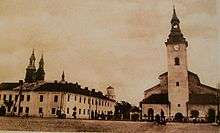
The Land of Wieluń (Ziemia wieluńska, Velumensis Terra) was a historic land of the Kingdom of Poland and the Polish-Lithuanian Commonwealth, which for centuries was part of Sieradz Voivodeship, Province of Greater Poland. It was based on the medieval Castellany of Ruda, which was established in the 10th or 11th century. The Castellany of Ruda was first mentioned in the 1136 Bull of Gniezno, and during the period known as Fragmentation of Poland (see Testament of Bolesław III Wrymouth, it was part of the Seniorate Province. In the late 12th century, the Castellany was acquired by Duke Władysław Odonic, and in 1217 it became property of Władysław III Spindleshanks. Later on, it was ruled by the Dukes of Silesia from the Duchy of Opole, and in the second half of the 13th century, returned to Greater Poland. In 1281, the castellany was moved from Ruda to Wieluń, and since then, it has been called the Land of Wieluń.
In both Kingdom of Poland and the Polish-Lithuanian Commonwealth, the Land of Wieluń had its own civil servants, offices and courts, and the Castellan of Wieluń was one of Senators of Poland. The land had four starostas - at Wieluń itself, Ostrzeszów, Bolesławiec and Grabów nad Prosną. Two deputies to the Sejm were elected at Wieluń's Sejmiks, furthermore, the Voivode of Sieradz was obliged to appoint his deputy from Wieluń.
The Land of Wieluń had its own coat of arms, established between 1410 and 1434. It can be found on the tomb of King Władysław II Jagiełło, together with coats of arms of Poland, Lithuania, Ruthenia, Greater Poland, and the Dobrzyń Land. Historically, the Land of Wieluń covers current counties of Wieluń, Ostrzeszów, Kępno and Wieruszów, as well as some locations in the counties of Olesno and Pajęczno.
History

In the early Middle Ages, the village of Ruda, located some 4 km (2 mi) from Wieluń, was the seat of a castellan and a Roman Catholic archdeacon, which made it the center of local administration. In the mid-13th century, however, the importance of Ruda diminished, at the expense of Wieluń, which was located in a more convenient spot. In 1281, the castellan's office was moved to Wieluń, and by 1299, the term Land of Ruda (Ziemia rudzka) had been replaced in documents by Land of Wieluń (Ziemia wieluńska).
The settlement of Wieluń was founded probably in c. 1220 by Duke Władysław Odonic. It was first mentioned in documents in 1282, and probably in the same year it received a town charter. In the mid-14th century King Casimir III the Great built a castle here, which was part of defensive system protecting the border between the Kingdom of Poland and Czech-ruled Silesia. The castle itself was remodelled several times, due to frequent fires and wars. Currently, there is a Classicistic palace in its location.
In 1370, following the last will of Casimir the Great, King Louis I of Hungary handed the Land of Wieluń to Duke of Opole, Władysław Opolczyk. In the same period, the Archbishop of Gniezno, Jarosław of Bogoria and Skotnik built a manor house in Wieluń. The town remained in the hands of Władysław Opolczyk until 1395, when it was returned to Poland. Wieluń quickly developed, in the 1390s a Paulists church together with an abbey were built, and in 1413, Archbishop Mikołaj Trąba moved the ancient collegiate church from Ruda to Wieluń. In the 1440s and 1450s, Wieluń was frequently destroyed in raids of Silesian dukes. By that time, it had already been an important center of commerce and government. It was also destroyed in the War of the Polish Succession, as the Battle of Byczyna took place near Wieluń.
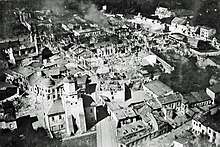

Wieluń prospered in the 16th century, the so-called Polish Golden Age. It was the capital of the Land of Wieluń, part of Greater Poland Sieradz Voivodeship. Good times ended in the catastrophic Swedish invasion (1655 - 1660), when the town was ransacked and burned both by the Swedish invaders, and by Polish troops, who took revenge on its Protestant residents for their support of the Lutheran Swedes. Finally, in 1707–1711, Wieluń's population was decimated by a plague (see miasma theory), which killed 2,000. Following the Partitions of Poland, Wieluń briefly belonged to the Kingdom of Prussia, and in 1815 it became part of Russian-controlled Congress Poland, where it remained until World War I. The town burned twice (1791, 1858), and after the second fire, it was rebuilt in a new shape.
On 1 September 1939, the city was bombed by the German Luftwaffe in the first action of World War II (apart from the Jabłonków Incident on 25/26 August). In the Bombing of Wieluń, German planes destroyed most of the town centre, including a clearly marked hospital, a synagogue, and the historic Gothic church, and killed at least 127 civilians.[2] According to Norman Davies, the bombings destroyed three-quarters of the town.[3] Thousands were injured and many fled. No Polish military units were present in Wieluń at that time (31 August - 1 September 1939).[2]
Wieluń was annexed to Nazi Germany on 8 October 1939 and placed under the administration of Reichsgau Wartheland. The Germans instigated a reign of terror against the Jewish population of Wielun, a population that had lived in the city since the 1500s and amounted to around 4000 people at the beginning of the war. Jews were kidnapped for forced labor with little pay. In 1941, they were forced into a ghetto. Many were then sent away to labor camps. In January 1942, the German publicly hung ten Jews. Later in the year, the 2000 Jews still remaining in the city plus others brought to Wieluń were rounded up and confined for several days in a church building without food or whater. Several died there of exhaustion, others were murdered. Nine hundred were then selected and sent to the Lodz ghetto. The rest were sent to the killing site, Chelmno, where they were immediately gassed. Seventy to one hundred Wieluń Jews survived the war and many returned to the city, although most left soon afterward.[4]
The city was liberated on 19 January 1945 by troops of the Soviet 1st Ukrainian Front in the course of the Sandomierz–Silesian Offensive.
Demographics
The majority of the population are Catholic.
- Number of inhabitants in years
- 1900: 7,361[5]
- 1909: 9,095; incl. 3,444 Jews (37.8%), 352 Protestants (3.9%) and no Mariavites.[6]
- 1931: 13,220[7]
- 2006: 24,347
Transport
Roads
Wieluń is an important transportation hub. Main roads stemming from Wieluń include connection with Warsaw (to the north-east) and Wrocław (to the west), via the National Road ![]()
![]()
![]()
![]()
Railways
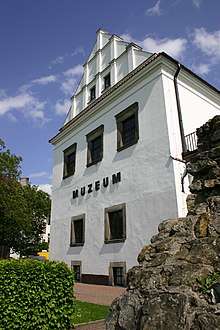
Rail connection links Wieluń to Poznań and Katowice. The line was built in the 1920s, as the junction of Kluczbork remained within borders of Weimar Germany and direct rail communication between Polish part of Upper Silesia and Poznań was impossible. Therefore, it was crucial to construct a brand new line, which runs from Herby Nowe to Kępno. The line was one of the most important connections in the Second Polish Republic, but after World War II, when Kluczbork was annexed by Poland, it lost its importance.
Also, until the end of the 1980s, there was a narrow gauge railroad, which connected Wieluń with nearby Praszka. Currently, the town has two operating railway stations: Wieluń Dąbrowa and Wieluń Miasto. Wieluń is directly connected by rail with such cities as Tarnowskie Góry, Katowice, Poznań, Szczecin and Kępno. Once there was also a direct connection to Częstochowa and Lubliniec. Another means of communication with the surroundings and the entire country are buses. There is a modern (though built in 1976) bus station, which also handles international communication.
Public transport
Wieluń, like most cities, has a municipal communications. In Wieluń runs 8 lines operated by a local transport company - PKS Wieluń. Public transportation has existed since 1988.
- Line A: Wieluń-Dąbrowa Railway Station – Rychłowice
- Line B: Gas bottling plant – Ruda
- Line C: Wieluń-Dąbrowa Railway Station – Olewin
- Line D: Kurów – Wierzchlas
- Line D – BIS: Wieluń-Dąbrowa Railway Station – POW street
- Line E: Gas bottling plant – Stare Sady housing estate
- Line G: Gas bottling plant – Częstochowska street
- Line H: Masłowice – Stare Sady housing estate
Notable residents
- Teresa Janina Kierocińska (1885-1946), a Polish nun
- Piotr Paweł Morta, a Polish political activist, dissident, economist, co-inventor, activist in underground "Solidarity"
- Jan Wątroba, bishop of Rzeszów,[8][9] in Poland.
Districts
- Downtown
- Armii Krajowej housing estate
- Bugaj housing estate
- Kopernika housing estate
- Stare Sady housing estate ("Old Orchards" housing estate )
- Wyszyńskiego housing estate
- Wojska Polskiego housing estate
- "Za szpitalem" (Behind Hospital housing estate)
- Niedzielsko
- Chrusty
- Berlinek
- Stodolniana housing estate
- Moniuszki housing estate
- Podszubienice
- Kijak
- Błonie
International relations
Twin towns – Sister cities
Wieluń is twinned with:[10]
See also
- Bombing of Wieluń in World War II
References
- Population. Size and Structure and Vital Statistics in Poland by Territorial Division in 2016, as of December 31 (PDF). Warszawa: Główny Urząd Statystyczny. 2017. p. 117. ISSN 2451-2087.
- "Oddziałowa Komisja w Łodzi (stan na maj 2018 r.). Śledztwo w sprawie zabójstwa przez lotników niemieckich w dniu 1 września 1939 roku, podczas bombardowania miasta, 32 pacjentów Szpitala w Wieluniu oraz kilkuset Polaków i Żydów, którzy zginęli w innych miejscach podczas bombardowania miasta, to jest o zbrodnię nazistowską stanowiącą zbrodnię wojenną (S 10.2004.Zn)". lodz.ipn.gov.pl (in Polish). IPN. May 2018. Retrieved 30 August 2018.
- Davies, Norman. "We must not forget the real causes of the war". independent.co.uk. The Independent. Retrieved 30 August 2018.
- Megargee, Geoffrey (2012). Encyclopedia of Camps and Ghettos. Bloomington, Indiana: University of Indiana Press. p. Volume II 114–115. ISBN 978-0-253-35599-7.
- Meyers Konversations-Lexikon. 6th edition, vol. 20, Leipzig and Vienna 1909, p. 601 (in German).
- Erich Zechlin: Die Bevölkerungs- und Grundbesitzverteilung im Zartum Polen (The distribution of population and property in tsaristic Poland). Reimer, Berlin 1916, pp. 90–91 (in German)
- Der Große Brockhaus. 15th edition, vol. 20, Leipzig 1935, p. 303 (in German).
- Diocese of Rzeszów, Poland, GCatholic.org.
- Bishop Jan Franciszek Wątroba.
- "Gmina Wieluń - Miasta partnerskie" (in Polish). Archived from the original on 29 July 2012. Retrieved 3 August 2013.
